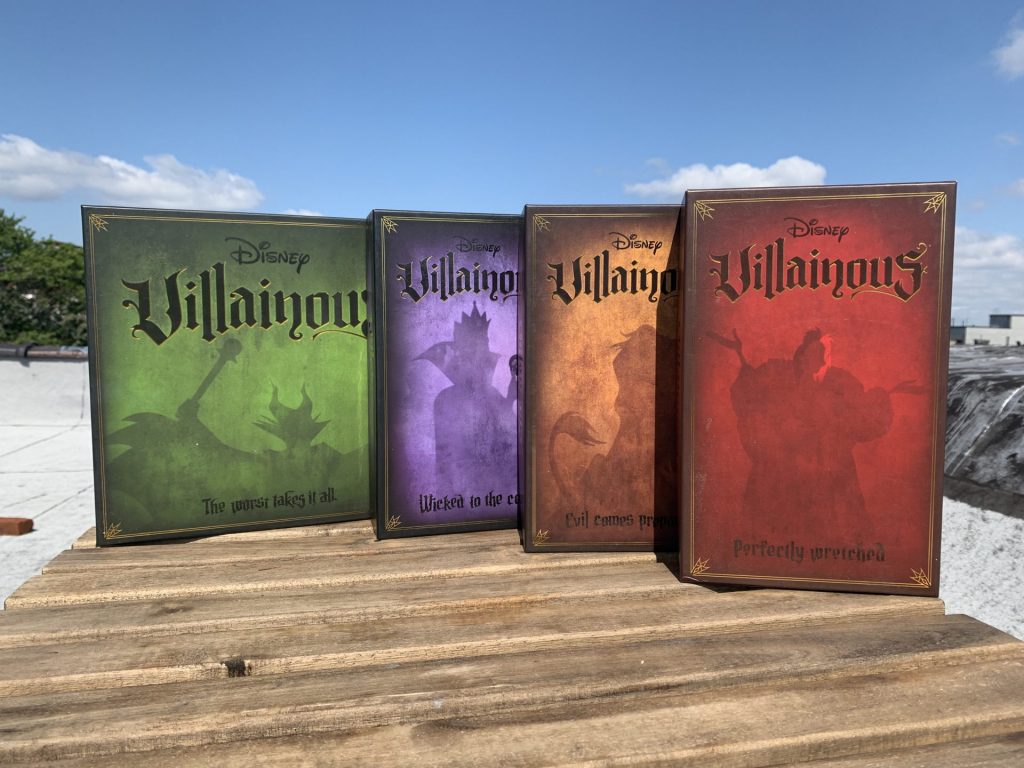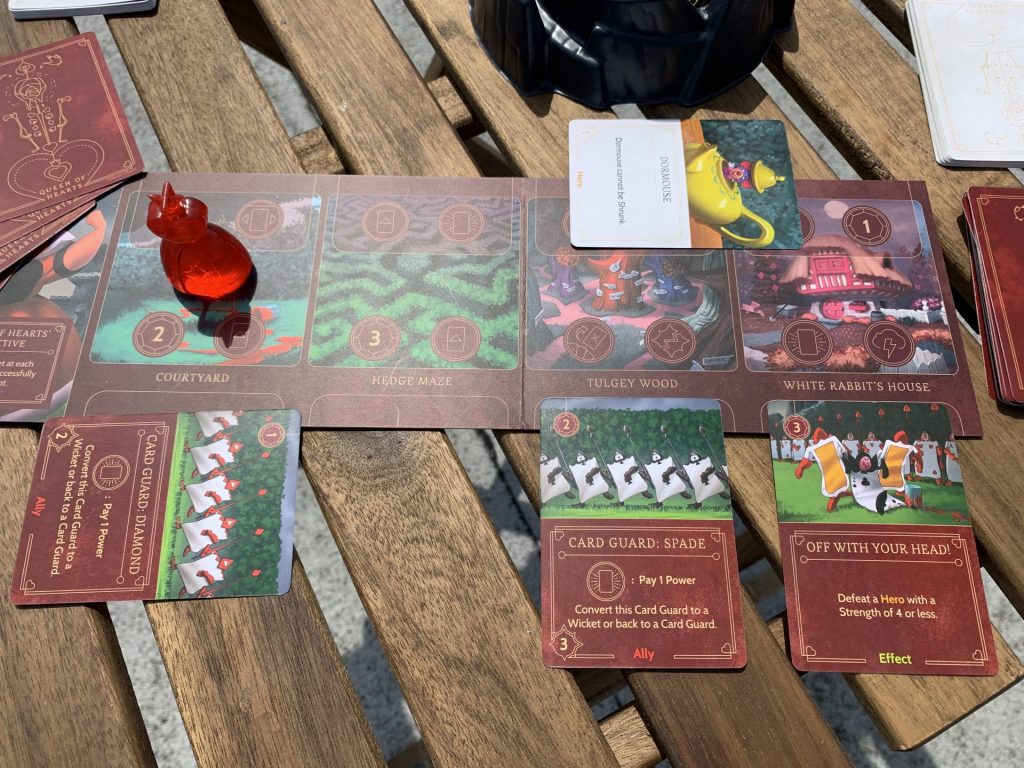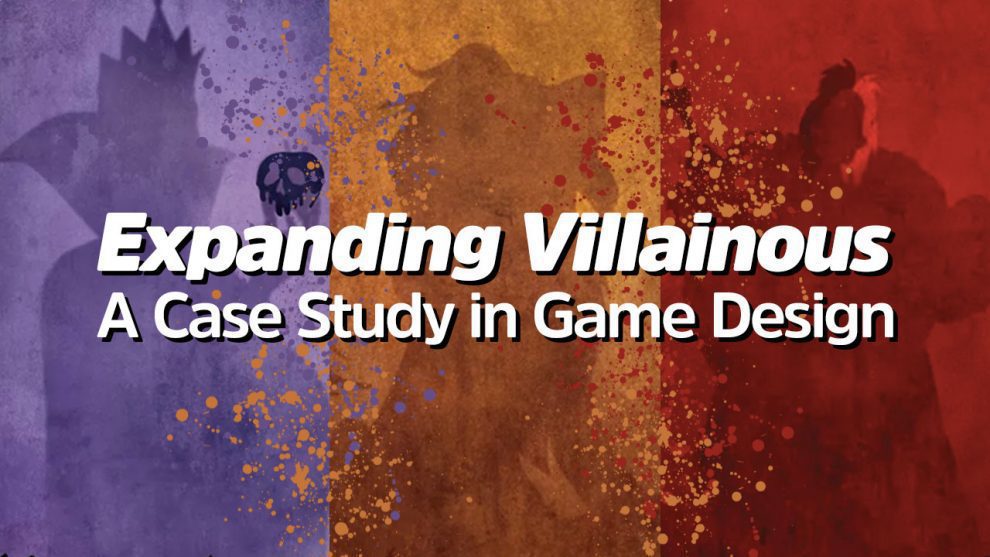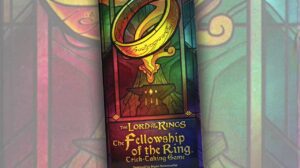A lot of people in The Hobby™ had low expectations for Disney Villainous, the 2018 board game from publisher Ravensburger and design collective Prospero Hall. There were several good reasons for this: Games based on pre-existing intellectual property have what could charitably be described as an uneven track record; Villainous is aware of itself as a commodity in a way that’s grating, like the kid in class who’s a little too eager to answer questions (full disclosure, I was that kid); and frankly it is very easy to be wary of any impasse into a niche hobby by the Disney behemoth.

I reviewed Villainous, and it’s fine. It’s okay. It’s an inspired idea that resulted in an alright game. I am not about to argue that it is some sort of secret masterpiece, but I would make the case that anyone interested in game design should give the Villainous family a close look.
The expansions, each of which is designed to work both with the base game and as a self-contained iteration of the franchise, can be seen as drafts or variations on a theme. When played sequentially, they provide a fascinating glimpse into the design process. Though the initial product is lackluster as a game, Prospero Hall learnt with each expansion, and improved accordingly. Playing Villainous in order, you watch Dr. Frankenstein figure out just what his Monster can do.
Scheme a Little Scheme of Me
For our purposes today, all you need to know is that Villainous is a card game where each player has two decks; the fate deck, which is used by other players to ambush you, and the player deck, which is used to accomplish your goals. These goals correspond to the villains’ stories in their original movies. Captain Hook has to defeat Peter Pan, Ursula has to capture King Triton, that kind of thing. What the game gets right in its first iteration is the premise; there is nothing like the sheer glee of taking on the role of your favorite villain and avenging their failures.

There’s a lot more that the game gets wrong. It’s a card game in the broad tradition of Magic: The Gathering, but there are no rewarding combos, and no puzzles to figure out. It’s too complicated to be truly social, and it’s not complex enough to be absorbing. Fating, a central part of the design and the only mechanism that allows for player interaction, is unpredictable and makes winning or losing feel entirely arbitrary.
There are issues related to playstyle. The titular villains come in two flavors: non-linear (Queen of Hearts, Maleficent, Prince John) and linear (Jafar, Captain Hook, Ursula). The non-linear characters achieve victory by playing certain cards to each location in their realm or by accumulating power tokens. They are much more fun. There’s less waiting, and interference from your opponents usually still leaves you with options. The linear characters win by completing an arcane series of steps. There’s a lot of waiting involved, a lot of fruitless draws and idle turns. And often the linear character strategies are dependent on a specific card; if one of your opponents destroys that card at just the right time, you might as well stop playing.
The final issue, and the most important, is that players are engaged in a race, but there’s no tension around who’s in the lead, who’s catching up, or who’s falling behind. That is an issue of readability, of how easily you can see where your opponents are in their schemes. The play state for most characters in the Villainous base game is obtuse to all but experienced players, and even they have to squint. The linear characters make progress in bursts by getting the right card and playing it. For most of the game there’s no way to know how close they are to victory without seeing their hands. The nonlinear characters are comparatively easy to keep tabs on, but only Prince John is readily readable, and he almost never wins as a result. Because ambushing is central to the game, we run into a conundrum: If a player’s progress is too obvious to other players, they’ll never win, but if it isn’t obvious enough, the act of ambushing loses any sort of strategic edge that might make it a satisfying thing to do for all but the most sadistic among us.
From the changes made with each subsequent expansion, I suspect Prospero Hall came to a similar set of diagnoses.
More, More, More
The first expansion, Wicked to the Core, included Hades from Hercules, the Evil Queen from Snow White, and Dr. Facilier from The Princess and the Frog. It is not a particularly successful expansion. The Evil Queen is too similar to the base game’s Maleficent, Hades is a real drag to play, and Dr. Facilier simply doesn’t inspire much joy. With that said, there are some critical tweaks to the formula that signify major shifts. Wicked to the Core is the draft where Prospero Hall figured out what doesn’t work.

They definitely seem to have picked up on the issues of readability and linearity, but for this second go at the system they zigged when they should have zagged. Hades is awful because he’s both mind-numbingly linear and readable from across the table, a perfect storm of the game’s worst traits. Dr. Facilier’s primary mechanism, a small pile of cards to which he and his opponents can add over the course of the game, is nonlinear and unreadable, making him more difficult to play against. Opponents are left to either lose sight of him entirely or blindly sabotage him based on a gut feeling. Neither is great.
If the impact of Dr. Facilier’s pile of cards on the group dynamic was mixed, it was also a breakthrough. Facilier was the first character to disprove one of the fundamental gameplay assumptions; suddenly, not every card needed to be played to your board. This idea would take on new dimensions with subsequent releases, but Wicked to the Core is when Prospero Hall realized that there were ways to reflect the characters not just in the cards they played, but in how those cards were used.
Bit by Bit, Putting It Together
The second expansion, Evil Comes Prepared, was a big step up from what came before, and the first set to include characters I wanted to play twice. Growing comfortable within the system they’d created, Prospero Hall started to give wilder ideas room to play. They weren’t afraid to tinker with every aspect of the system.

The lessons taken from Wicked to the Core were well learnt. The stories for the characters, their motivations and personalities, started to affect the mechanisms of the game. The victory condition for Ratigan, Vincent Price’s wonderful rat from The Great Mouse Detective, can change depending on what happens during the game. At first, he wants nothing more than to build a mechanical rat queen and install her in Buckingham Palace, a pretty standard linear goal. But if his machine is destroyed by another player before he succeeds, Ratigan becomes consumed with rage, obsessed instead with defeating his nemesis. Not only is this wonderfully evocative of his character arc, it puts a brilliant pressure valve on a linear design. While a character like Jafar is pretty much out if someone discards the lamp late enough in the game, Ratigan pivots to a new goal, one that is likely still within reach.
And then there’s Yzma, who takes the inch afforded by Dr. Facilier and turns it into a mile. Throughout the film The Emperor’s New Groove, Yzma is looking for the emperor Kuzco. In the game, this search is approximated by dividing one of Yzma’s decks into four piles. Throughout the game, she attempts to find the Kuzco card, while other players shuffle different piles together and deal them back out. Dead time between turns is an issue in Villainous, but Yzma encourages everyone to pay attention. There’s nothing like shuffling the last place Kuzco could be together with a pile where Yzma knew he wasn’t. It is Whack-a-Mole and a shell game mixed into one, and it can be a blast. Yzma remains my favorite design in the series, a perfect example of content dictating form.
There were numerous other improvements to the design on a smaller scale. The third villain in the set, Scar from The Lion King, showcased noticeable improvement to the card play. Setting up my hyenas and wildebeests for optimal effect was the first time Villainous gave me an opportunity to feel clever. It also seems as though the fate cards became less unpredictable in their effects, decreasing the chances that a player would be routed by an unfortunate draw, but that may well be a function of how the character goals metamorphosed. For the first time, Villainous felt like it worked.
Better, Faster, Stronger
All of the improvements made over the previous entries meet to wonderful effect in Prospero Hall’s last contribution to the franchise, Perfectly Wretched. It is unambiguously the best Disney Villainous has to offer. Ease of readability was a liability for Prince John in the base game, since he was so easy to keep tabs on, but by Perfectly Wretched the team had turned that liability into an asset. All three new characters, Cruella deVille of 101 Dalmations, Mother Gothel from Tangled, and Pete from “Steamboat Willie,” have visible indicators of their progress. Suddenly you could feel another player chipping away at your lead. That sense of tension I mentioned was so lacking from this gussied up race game was suddenly palpable.

Two of the three characters brilliantly marry their story to their mechanics. DeVille has to find and collect puppies in the form of numbered tokens, clawing her way to the titular total of 101. Mother Gothel is constantly chasing Rapunzel around the kingdom, trying to accumulate trust tokens while keeping the girl in her tower. When I first looked over the character roster, I was less excited about Gothel than I had been about any other character in the series, and she ended up being entertaining not only to play, but to watch. If I have one criticism of the box—and I don’t, really, I just want to be consistent here—it is that Pete has no sense of theme whatsoever. You win by flipping over four challenge tokens. It’s not thematic, but it is so fun to play that I don’t mind. Working out how his cards will help you complete those challenges is incredibly satisfying. Pete feels like being in an arcade, the bells going off and the lights flashing every time you pull something off.
Because none of the characters are ever trying to do one specific thing or waiting on one specific step unless they are close to winning, the game flows better. Everyone stays tuned in, and everyone has a good time. Fating feels more like messing with your friends rather than ruining their night, which makes it much more entertaining and far less frustrating. It’s still not a particularly deep game, but with the third expansion, Villainous was finally, unambiguously, fun. At last, the experience of playing the game lived up to the thrill of hearing it described. Perfectly Wretched is, truly, the final draft of Disney Villainous.
And Now the End Is Near
There is so much to learn here, for designers of all stripes. Prospero Hall were smart about how they made adjustments, learning both from what they did right and what they did wrong. As a result, the game grew by leaps and bounds. You could argue, and I wouldn’t disagree, that everything I’ve described here should have been ironed out before the first game was released. I could easily frame this as a horror story of bad game design, of premature deadlines and insufficient development.
I would rather look at it as a story of exploration and discovery, because those are the lessons I draw from it. Game design is difficult, finicky, and unforgiving, but look at how much better an idea can become with the right adjustments! What started out as a lackluster game with a couple of good gimmicks turned into a good game. A deceptively difficult title to teach and grok has turned into an engaging and immediate thrill.
I think it’s amazing that thousands upon thousands of copies of this weird game have been sold. I understand the cynicism about Disney products, and I can tell you with all honesty that I never want to play Villainous again, but I can’t wait to see what games come from the kids who grew up learning the lessons Disney Villainous has to teach. Those games will be something truly extraordinary.











One could say that Ravensburger and Prospero Hall made well considered calculations for this game series. As a big box store game aimed at non-gaming and Disney loving audience, their simple card game with the initial box set may have been the gateway game to loop in new players (much the way Wingspan attracted naturalist to board gaming). As the audience grew, so did the complexity and gameriness. Once hooked (or a completionist as many Disney collecting fans may be), they had a following that could include gaming hobbyists as well. The commercial teams at these companies made and executed an extremely well thought out marketing plan to grab the market share they knew they could.
The people behind this game are absolutely very smart, sueyue, but I would make just the opposite argument. I think the game has become significantly *less* complicated and significantly *more* fun with each expansion. I have numerous non-gamer friends who have tried to play the base game and could not keep track of what they were supposed to do. Even though the base game is more mechanically uniform, it is significantly harder to pick up because most of what you have to do is not intuitive. I have a few friends who have tried to play the base game of Villainous because of the Disney branding and found it too complicated!
It’s a shame you never want to play Villainous again, what with the new expansion to see if your theory on trajectory still tracks. If you ever get around to looking at it your thoughts would be welcome!
“Despicable Plots”
Thank you very much for saying so! I have played “Despicable Plots,” but I don’t see myself writing about it unless something changes. I didn’t include it in this article because Prospero Hall left the project and design responsibilities were taken over by Michael Mulvihill. Overall I thought the expansion was a big step backwards for the franchise. It is possible I will be writing about Marvel Villainous at some point in the future, since that’s still Prospero Hall and they made some changes to the system, but there are so many games I would rather be playing.
I didn’t enjoy this take on Villainous but thank you for the well written piece. I think you overplay the game design lessons that can be drawn from the game/what Prospero Hall learned as they developed the franchise. Or I don’t think Evil Queen or Dr Facilier would have been differently designed even if they arrived in the last expansion as opposed to the first.
I’m sorry to hear you didn’t enjoy it, Rubio! Like any piece of in-depth analysis, this is an articulation of the lessons that I personally draw and the connections between the dots that I see, and others can and will of course feel differently. The world would be a boring place, or the piece would be a boring one, if we all agreed. Whether Prospero Hall consciously made the alterations I highlight between expansions or not, whether or not they were aware of any of what I talk about, I think the lessons are still there to be learnt. I’d be surprised if they didn’t, though; their final expansion is a significantly different game than the base game, and I doubt that’s a coincidence. Convinced or not, I appreciate you taking the time to read it and respond!